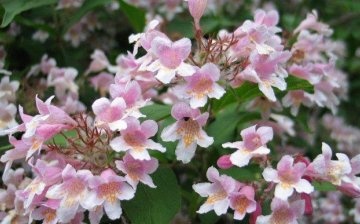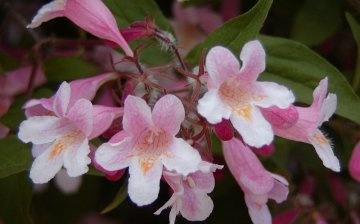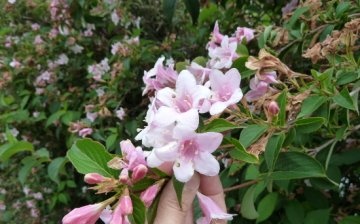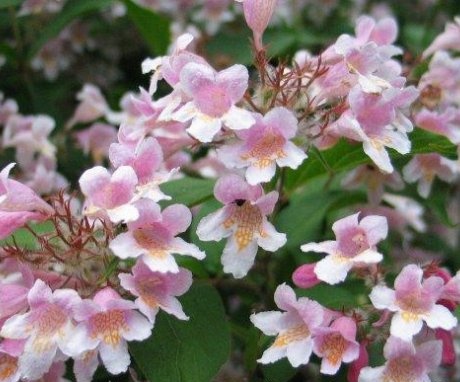Kolkvitsia is a beautiful ornamental shrub on your site
The adorable Kolkvitsia is a beautiful ornamental bush. It grows in almost all regions, including the middle lane. Undemanding in leaving.
Content
Kolkvitsiya: description
The homeland of the charming colquation is central China. Her closest relatives - known to many honeysuckle and weigela... It has been cultivated since the 19th century. Then it was grown in the Baltics, Ukraine, Central Asia.
Features of the structure of the bush:
- This shrub is sheaf-shaped. Its height depends on the climatic zone. In the southern regions, it reaches 2 m and even 2.5 m. In the northern regions - 0.8-1 m. They delight the eye with beautiful leaves, shoots, flowers.
- Young twigs are covered with a dense, short edging. They are vertical or slope downward. The bark of older branches is red-brown in color. Over the years, it exfoliates, giving the plant an original look.
- Leaves with rounded bases and pointed tops, whole, up to 5 cm long. Dark green above, whitish below from the villi covering them. In autumn, the leaves turn bright yellow. But not at the same time, therefore they have colors of different degrees of saturation. This makes the bush colorful, even more decorative.
- At the beginning flowering it is covered with bright pink buds. Then they brighten, open, revealing a variegated or monochromatic (depending on the variety) middle.
- Small bell-shaped flowers with five curved petals, 1.5 cm in diameter, light pink edges. They are collected in pairs in corymbose inflorescences with a diameter of 7 cm.
The scent is not strong, but pleasant. And the bush is very beautiful during flowering. It is not for nothing that the plant is called "pleasant colquitia" or "charming", "flower of love".
Colquitia blooms from mid-May to late June.
There are a lot of flowers, they cover the entire bush, bending over thin branches. Kolquitia is used to create mixed flower beds and other elements. landscape design... It is often placed near natural or artificial reservoirs. The wild-shaped shrub is beautiful. But cultivated varieties are even more attractive. Their flowers are larger, and the colors are more varied.
Varieties cultivated in Russia:
- Rosea with pink flowers.
- Pink Cloud, whose bright pink flowers open before wild-growing forms.
- The fruits of the colquitia are dry, covered with small bristles, inedible. They are used only for reproduction. They ripen in August.
Reproduction methods
Colquition is propagated:
- Wild varieties are easy to propagate seeds... But they are hard, covered with hard protrusions. Therefore, germination is not easy to achieve. To speed up the process, rub the seeds with sand (scarify). The hard surface of the seeds is removed. They can be sown into the ground, deepening by half a centimeter. For 1 running meter you need 1 g of seeds. They germinate at 20 ° C. For spring sowing, stratification wet seeds at low temperatures for at least two months. You can treat them with high concentration sulfuric acid for 10 minutes. So that moisture does not evaporate from the area where the seeds are sown, it mulch a layer of humus or peat. After the seedlings reach a few centimeters, they are dived, planting at a distance of 10 cm from each other.
- Reproduction cuttings not very effective. They take root well, but most of them die in winter. This happens when the soil freezes. To protect them, dishes with cuttings are hidden in the basement or cold greenhouses. Their frost resistance grows every year.
- Cultivars are best propagated by horizontal layers. To do this, in early spring, all the shoots growing downward are dropped into the holes, sprinkled with fertilized soil. As a result, the escape will be half underground. In this part, the roots of the new plant will form. By the fall, new bushes will be ready for replanting to a new location.
- Dividing the bush produced in autumn. They choose a fairly young, but already thick bush, water it, dig it up. Then it is carefully divided into two or three parts and planted in a permanent place.
Shrub growing conditions
Kolkvitsiya is very undemanding to growing conditions. It easily tolerates heat and frost up to 30 degrees, drought and heavy rains. It can grow on any soil, including alkaline. But with good care it looks prettier. At two to three years of age, the seedlings are transferred to a permanent place. Select areas with bright sunlight. It's not bad if the bush is slightly shaded in the sun. If you plant a colquation in the shade, then it will lose its decorative effect.
In winter, colquitia does not tolerate northern winds well. Therefore, it must be placed in such a way as to protect it from their effects.
Kolkvitsiya is planted in a permanent place after the soil warms up well. Bushes with a closed root system (from pots) take root better. The soil for planting kolkvitsiya is selected sandy loam, light. It will allow water and air to pass through, while moisture will not linger near the roots. Transplant produced in cloudy weather or in the evening. Then the plant will take root faster. The roots are updated with secateurs, cutting off 1 cm each. Damaged roots are removed.
To create decorative hedges kolkvitsiya is planted at a distance of half a meter from each other.
For normal plantings, one and a half meters are left between the bushes. They dig shallow holes, up to 50 cm.To prevent water from accumulating near root system, lay a layer of sawdust, old hay, humus. A bush of kolkvitsiya is planted on top. The area around the planted bush is mulched, first with hay, straw, then cut grass. You can use peat, wood chips. Mulch protects the root system from overheating in summer and frost in winter. If all conditions are met, the bush begins to release shoots after 10 days. And after another 10, buds will appear.
Care Tips
Kolkvitsiya does not require special care. In order for the plant to take root, it is watered, the mulch of the trunk circle is constantly renewed. Its thickness should be at least 10 cm, diameter - 15 cm larger than the size of the crown. In the future, remove weedsloosen the soil around the bush. In early spring or autumn, old and winter-damaged branches are removed.
In order for the bush to bloom as long as possible, you need to create suitable conditions for it:
- Sufficient moisture.
- Sunny place or light partial shade.
- Soil rich in nutrients.
- Regular removal of dead buds.
Cultivars require more careful leavingthan wild relatives. These are frequent watering (a bucket of water per bush), the introduction of nitrogen (nitroammophoska) and phosphorus (superphosphate) under the bush fertilizers... If possible, install the system drip irrigation... You need to water at the root, without falling on the flowers.
After flowering cut weak, thin branches with pruning shears.
Cropped too long. The cut plant tolerates severe frosts better, grows more actively. The Rosea variety is not as frost-resistant as the wild one. Especially often its shoots, which did not have time to ripen, are damaged by autumn frosts in the northern regions. In the spring, such shoots are removed, new ones grow instead.
You can cover the bush with non-woven materials for the first year for the winter.But the main thing is to preserve the root. So that in winter it does not freeze out, they cover the near-trunk circle with sawdust, spruce branches. The adorable colquitia is not damaged diseases and pests... But sometimes, during the period of long rains, it can be attacked by aphids or leaf-eating pests.
The beauty and showiness of the shrub can be seen in the video.
















